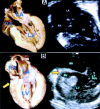Anatomic-echocardiographic correlates: an introduction to normal and congenitally malformed hearts
- PMID: 11709529
- PMCID: PMC1766550
- DOI: 10.1136/heart.86.suppl_2.ii3
Anatomic-echocardiographic correlates: an introduction to normal and congenitally malformed hearts
Figures



















Similar articles
-
Conventional roentgen examination in congenital heart disease.Radiol Clin Biol. 1970;39(2):89-101. Radiol Clin Biol. 1970. PMID: 5426159 No abstract available.
-
[Chest survey films for isolated congenital heart defects in infants and children (author's transl)].Fortschr Geb Rontgenstr Nuklearmed. 1973 Aug;119(2):147-50. Fortschr Geb Rontgenstr Nuklearmed. 1973. PMID: 4357577 German. No abstract available.
-
Axial cineangiography in congenital heart disease.Radiol Clin North Am. 1980 Dec;18(3):515-46. Radiol Clin North Am. 1980. PMID: 7455041
-
Transoesophageal echocardiography in adult congenital heart disease.Heart. 2001 Dec;86 Suppl 2(Suppl 2):II30-II40. doi: 10.1136/heart.86.suppl_2.ii30. Heart. 2001. PMID: 11709532 Free PMC article. Review. No abstract available.
-
The roentgen diagnosis of congenital heart disease.Cardiovasc Clin. 1970;2(1):115-37. Cardiovasc Clin. 1970. PMID: 4255637 Review. No abstract available.
Cited by
-
Association of promoter methylation statuses of congenital heart defect candidate genes with Tetralogy of Fallot.J Transl Med. 2014 Jan 31;12:31. doi: 10.1186/1479-5876-12-31. J Transl Med. 2014. PMID: 24479926 Free PMC article.
-
Anatomy of the atrial septum and interatrial communications.J Thorac Dis. 2018 Sep;10(Suppl 24):S2837-S2847. doi: 10.21037/jtd.2018.02.18. J Thorac Dis. 2018. PMID: 30305943 Free PMC article. Review.
-
Methylation status of CpG sites in the NOTCH4 promoter region regulates NOTCH4 expression in patients with tetralogy of Fallot.Mol Med Rep. 2020 Nov;22(5):4412-4422. doi: 10.3892/mmr.2020.11535. Epub 2020 Sep 24. Mol Med Rep. 2020. PMID: 33000281 Free PMC article.
-
CpG island shore methylation of ZFPM2 is identified in tetralogy of fallot samples.Pediatr Res. 2016 Jul;80(1):151-8. doi: 10.1038/pr.2016.42. Epub 2016 Mar 9. Pediatr Res. 2016. PMID: 26959486
-
De novo 9q gain in an infant with tetralogy of Fallot with absent pulmonary valve: Patient report and review of congenital heart disease in 9q duplication syndrome.Am J Med Genet A. 2015 Dec;167A(12):2966-74. doi: 10.1002/ajmg.a.37296. Epub 2015 Aug 19. Am J Med Genet A. 2015. PMID: 26768185 Free PMC article. Review.
References
Publication types
MeSH terms
LinkOut - more resources
Full Text Sources
Medical
